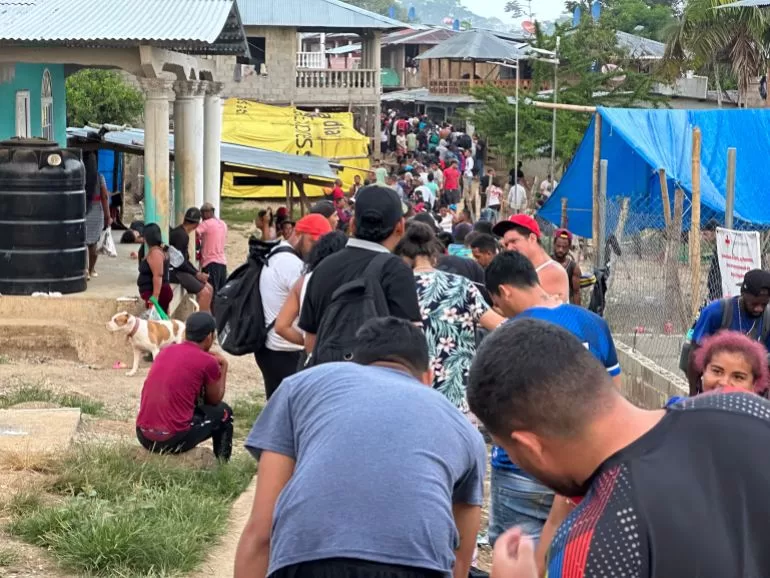No paved roads lead to the town. Only dirt paths and the Turquesa River connect Bajo Chiquito to the outside world. A dense jungle filled with parrots and howler monkeys cocoons the community.
But over the past few years, the lives of the Emberá-Wounaan people who call Bajo Chiquito home have been dramatically and perhaps irreversibly transformed.
That is because, over the last several years, Bajo Chiquito has mushroomed into a hub for one of the busiest migration routes in the Western Hemisphere.
Hundreds of thousands of people now cross from Colombia into Panama each year, using a narrow land bridge called the Darién Gap. Bajo Chiquito sits at the northern edge of its most popular trail: The Colombian border lies a mere 24km (15 miles) away.
“When I was a boy, it used to be silent here,” said Saray Alvarado, a 27-year-old local who works in a shop that recharges migrants’ phones for a fee.
The street behind him bustled with large crowds more befitting of a city. “A lot has changed,” he told Al Jazeera.
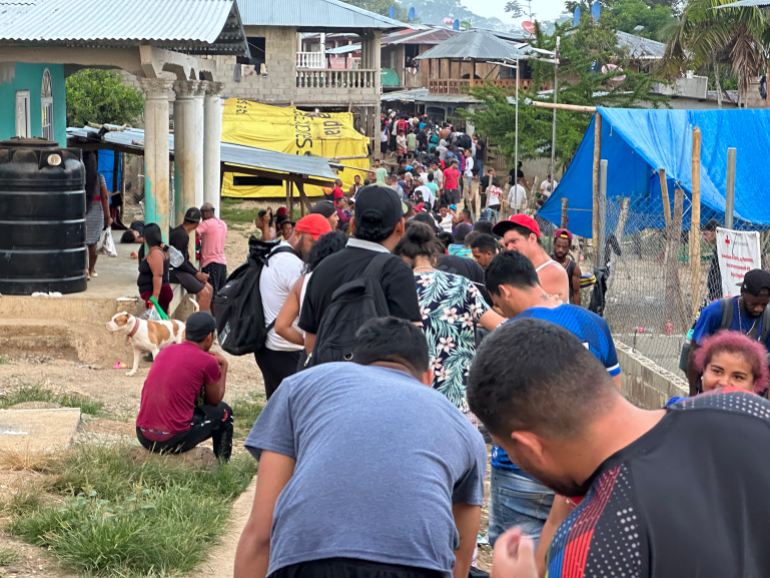
An influx of visitors
Last year was the busiest yet for Bajo Chiquito and the Darién Gap as a whole.
In 2023, a record 520,000 migrants and asylum seekers made the days-long trek through the Darién’s deadly terrain, which is often muddy and steep.
Many are headed north to the United States border, often travelling from crisis-stricken countries like Haiti, Venezuela or Ecuador.
But others have come from farther away, in Asia, Africa and Europe. Due to immigration restrictions limiting their ability to fly into the US, they too make the trek on foot.
The number of travellers, however, has been steadily rising in recent months. In 2020, just 8,500 migrants and asylum seekers crossed the Darién Gap. But in every year since, a new record has been set.
The year 2021 saw the first big spike, with the Panamanian government documenting 133,000 people in the Darién Gap. Then, in 2022, the upward trend continued, with 248,000 travellers counted.
Now, Bajo Chiquito receives more than a thousand migrants and asylum seekers each day. Panamanian authorities process the new arrivals, as they prepare to board boats to the nearest road, four hours away.
As many as 4,000 people have descended on Bajo Chiquito in a single day, according to a January report from the United Nations Children’s Fund (UNICEF). The temporary population vastly outnumbers the town’s permanent residents, who add up to about 500 in total.
Hundreds of tents now line the village paths, as exhausted migrants and asylum seekers rest before continuing on their journey.
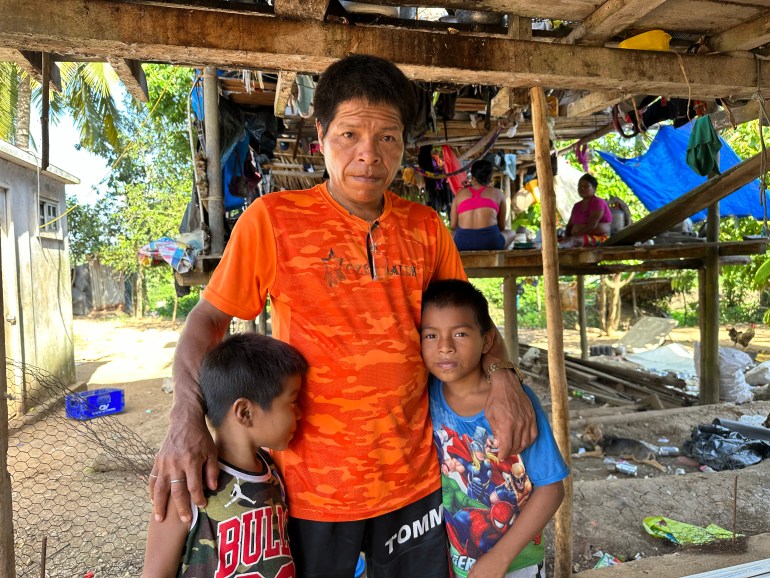
A boom town in the jungle
As a result of the influx, local businesses do a roaring trade selling food, water, accommodations, electricity and internet access. There is even a Western Union facility for those needing to wire money in.
“It’s a spectacular economic opportunity for them,” said Bram Ebus, the lead author of a report about the Darién Gap from the International Crisis Group, a nonprofit. “And we shouldn’t stigmatise them for profiting from it. They are providing services that the state isn’t offering.”
Experts estimate the community is earning tens of thousands of dollars a day due to the migration.
Migrants and asylum seekers generally must take two boat rides to pass through Bajo Chiquito: one to enter, the other to exit. Each trip costs $25 per person. Then there is the need to stock up on basic supplies as they continue their trek north.
With the income from the bubbling demand, many residents are opening up businesses, renovating houses or building new ones. Others have bought new boats or invested in high-speed Starlink internet.
“Before we lived in straw huts, but now we have concrete buildings,” said Esteban Chami, a 46-year-old resident who recently bought a solar panel for his house. He has also been able to pay for one of his sons to go to university, thanks to the funds he made from selling food and internet access.
The demand for labour has become so acute that workers from other parts of Panama are being hired to drive boats, serve in restaurants or help with construction in Bajo Chiquito.
Luis Ortega, 27, arrived five months ago from the community of Rio Chico, which is about three days’ travel by boat. He came in search of employment.
“In my hometown, there are no jobs,” said Ortega. “I came here to make money. But I will go back after a little while.”
He now helps to transport migrants in motorised canoes made of wood.
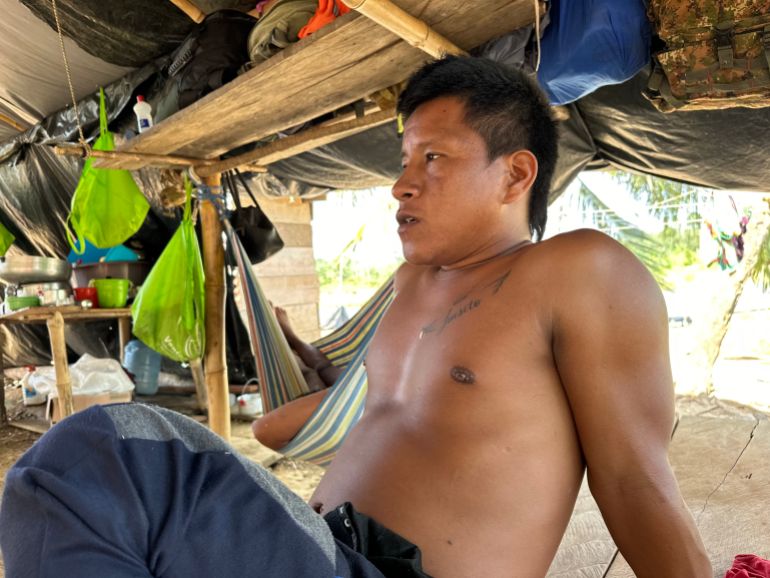
Preserving local culture
But the unprecedented arrival of migrants and asylum seekers has been a double-edged sword for the Indigenous people of the Darién Gap.
“It’s a huge influx of people for such a small community,” said Giuseppe Loprete, the International Organization for Migration’s head of mission in Panama. “For them, it’s a serious amount of money flowing in. But we are concerned for many reasons.”
Experts say communities like Bajo Chiquito are drifting away from traditional agricultural practices like growing plantain and rice, instead importing processed food to satisfy their needs.
Part of the logic is practical. A day of farm work might earn $15, but catering to the flow of migration could easily bring in triple the income. But experts fear a loss of traditional customs and knowledge, not to mention nutritional concerns.
Nelson Ají, the elected leader of Bajo Chiquito, told Al Jazeera he worries that Emberá-Wounaan culture might become diluted by outside influences. The community as a whole has become less self-sufficient, relying more and more on outside goods and trade.
“The culture of the community was much stronger previously,” Ají said.
But the blossoming local economy has been transformative for Bajo Chiquito, which has long struggled with poverty.
In 2022, the International Labour Organisation, a UN body, found that 38.4 percent of the 272,000 Indigenous people in Panama are unemployed. Those rates are particularly high in rural areas like Bajo Chiquito.
A study by the World Bank in 2000 estimated that 80 percent of Panama’s Emberá-Wounaan population lives in poverty.
Ají explained that he had banned children under 18 from working, as boat drivers after he noticed an increasing number of kids dropping out of school to work.
“The whole economy of the local community has changed,” said Margarita Sanchez, a UNICEF field coordinator based in the Darién Gap. “Children are helping their parents with their services provided to migrants and are leaving school.”
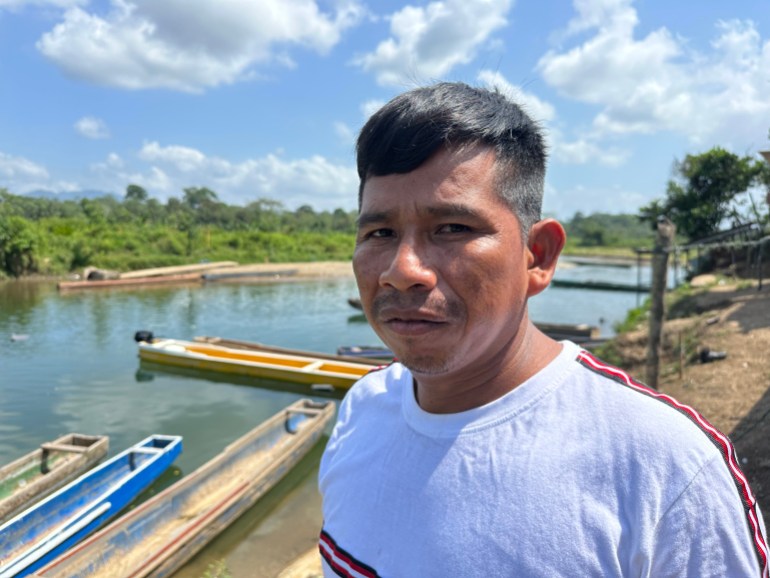
Alone to face the crisis
The heavy flow of migrants and asylum seekers has also placed a strain on the town’s meagre infrastructure.
Bajo Chiquito has no sewage system or electricity network. While a small water purification facility and a health centre have been built in recent years, their capacity is too small to support the number of people passing through, locals like Ají say.
“We need help with healthcare, water and electricity,” Ají explained as he stood on the banks of the fast-flowing Turquesa River. “We need better organisation to process the migrants, and we need better spaces for them. We are being left to deal with this crisis on our own.”
Panama’s Ministry of Social Development did not respond to a request for comment.
But Ají’s observations were echoed by those of Caitlyn Yates, a researcher at the University of British Columbia who has worked in the Darién region, including Bajo Chiquito, since 2018.
“That area of the country has lacked investment and has very much been left behind,” Yates told Al Jazeera. “And there are gripes within the communities that the state is now only paying attention to them because of the arrival of the migrants.”
Meanwhile, new issues are cropping up as a result of the population boom, including pollution.
Plastic bottles and other waste now litter the streets and surrounding forest. With limited sanitation facilities in the Darién Gap, some migrants and asylum seekers defecate in the Turquesa’s waters, which creates health issues for the residents who rely on it to quench their thirst.
“We can’t drink the water any more,” Ají said. “It’s dirty. People throw their trash in the river. And a lot of migrants die in it.”
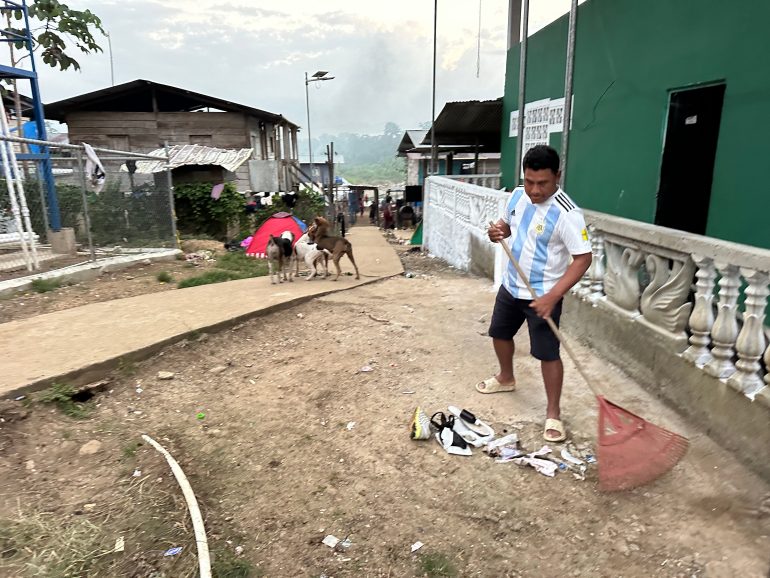
Still, community leaders and experts fear what may happen to Bajo Chiquito when the flow of migration eventually dries up.
“It is going to be very difficult for them to return to life as it was before,” said Ebus from the International Crisis Group.
But the dire circumstances the residents of Bajo Chiquito face have proven to be a source of common ground with the migrants and asylum seekers passing through.
Members of the community told Al Jazeera they give jobs to the travellers so that they can pay off debts and earn extra money to continue the journey ahead. They also sometimes feed and house penniless arrivals without expecting payment in return.
“We’re brothers. We are human beings,” said Ningen Túnel González, a 54-year-old resident, as he swept rubbish from the street. “We understand why they are migrating: for money, mistreatment and violence. So we do what we can to help them.”
